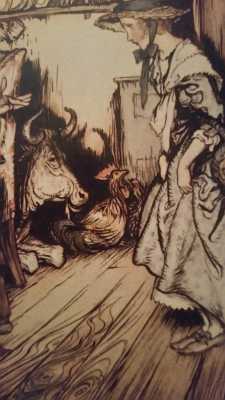Scattering Violets
An exploration of funerary traditions and innovations, care of the dead, and pagan perspectives on death
Chicken Magic in Folktales and Lore
Chickens are humble animals. They’re heavy, mostly earthbound birds, spending their days pecking at the ground, clucking or crowing, bobbing their heads as they strut around the farmyard. They don’t exactly radiate mysterious elegance in the way that cats and rabbits do. However, when we look closely at European folk tales and medieval lore, we see that chickens very much had a significant place in European folk magic, especially as creatures of protection and sacrifice.
In lore about the river-dwelling Nickelman, or Nixie, Benjamin Thorpe notes that “in Thale they were formerly obliged annually to throw a black cock into the Bode [River]; for if they omitted to do so, someone would certainly die within the year” (87). Claude Lecouteux makes note of this kind of sacrifice several times in The Tradition of Household Spirits, one example being:
“An old woman holding a black chicken in her hand entered the first room; once she passed over the doorsill, she secured the bird between her legs and slit its throat with the blade of a knife. She poured its blood in front of the house and when the animal was on the verge of expiring, she spilled the last drops on the threshold. The dead bird would then be roasted and served at the meal following the sacrifice" (29).
The witness questioned the old woman, who answered him as follows:
‘It is to avoid one of the inhabitants of this house dying during the next year. I do the same thing for all new construction…'” (ibid.)
Lecouteux explains that when a new house was constructed, the nature spirit dwelling on the land would be compelled to become the spirit of the home. In order to appease this spirit, who would be offended that its home was being violated and occupied, a sacrifice would have to be made — human or animal. There are ancient accounts and archaeological evidence of humans being walled up in the home or laid in the foundation, but as time passed, animal sacrifice superceded that of humans.
It’s important to note the recurrence of the color black above. Lecouteux explains that “among the Votes of Joenpera [in Finland]…before building, the ground would be worked while holding a black rooster by the wings, because it was said evil spirits feared the color black.” Black is a protective, warding color, repelling evil.
Chickens also feature as sacrificial animals in folk tales, namely “Hansel and Gretel” and “The Seven Ravens.” In “The Seven Ravens,” a girl who is looking for her long-lost brothers (transformed into ravens) comes to the stars for help:
“When the morning star arose, it gave her a chicken bone, and said, ‘Without that chicken bone you cannot open the glass mountain, and your brothers are inside the glass mountain.'”
However, she loses the chicken bone before reaching the glass mountain and sacrifices one of her fingers to use as a key in its place.
“Hansel and Gretel” flips the scenario: the witch wants to touch Hansel’s finger to test its fatness, but Hansel holds out “a little bone” to the poor-sighted witch instead, which convinces her that he’s still too thin for eating. While the story doesn’t explicitly state that it’s a chicken bone, it’s reasonable to assume as much because a) he is a child, and the size of the bone must be roughly equivalent to the size of his actual finger, and b) chickens were essential fixtures in households in the past, so it’s not unreasonable to assume that the bones would be around the witch’s home. It is interesting that folklorists Iona and Peter Opie consider this tale to belong to “a group of European tales especially popular in the Baltic regions, about children outwitting ogres into whose hands they have involuntarily fallen.” With “ogre” being a word of French origin (possibly derived from a word in the Etruscan language), it is more likely that the beings mentioned were more akin to giants (jotnar, or “devourers”) or similar spirits. Each story shows the use of chicken bones as sacrificial objects to supernatural beings, either to escape death or gain entry into other realms, as decoys for human sacrifice, very much echoing Thorpe’s and Lecouteux’s research.
The important position of chickens in folktales and lore brings up an important point: while these fussy, rotund, and humble animals were regular fixtures of everyday life, they also held significant power. Too often, our culture divides the magical and the mundane, the sacred and the profane. But our ancestors understood that mysticism and magic are woven into the fabric of everyday life, not apart from it. By choosing to see this, we can perhaps regain a little of what has been lost — that earthy, messy magic that still runs deep in us.
Works Cited
Lecouteux, Claude. The Tradition of Household Spirits. Inner Traditions, 2013.
Thorpe, Benjamin. Northern Mythology. Vol. 3, Lumley, 1851.
Image by Arthur Rackham
Comments
-
Please login first in order for you to submit comments
















